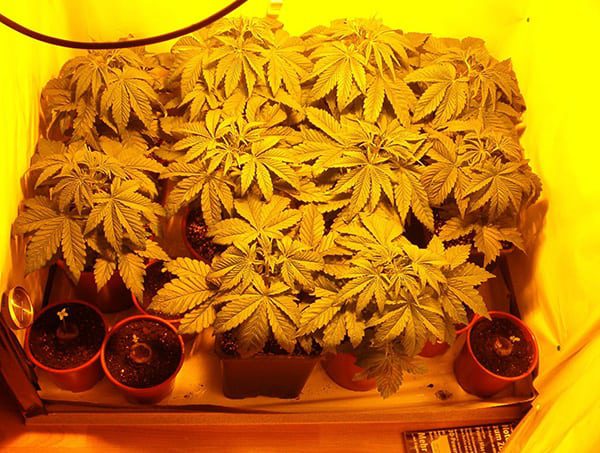Pot, Power, and Politics
Legal marijuana, cultivated indoors on a large scale, poses a growing threat to electrical safety and a booming new business demand for electric power.
Legal marijuana cultivation is posing electrical problems in three of the four states where recreational cannabis use is now permitted. The problem is that indoor growing operations—long a production staple when weed was forbidden—use a lot of electricity and are often jury-rigged without attention to safety codes.
Pacific Power, which serves both Washington and Oregon, says indoor pot farms and their high-intensity grow lights have caused increased electrical safety concerns in both states. These are often home-based operations that are legacies from the days when cannabis was illegal.

Oregon-based Pacific Power reports seven incidents since July 1 where home-based growing operations have overloaded local equipment, causing outages. “What most people don’t realize is that growing marijuana is a very intense power use,” said Roger Blank, Portland-based Pacific Power safety director. “From a power use stand point, even a small operation of four plants with standard lights is like hooking up 29 refrigerators that run 24/7.”
Portland General Electric, supplying power to large swaths of Oregon, also has pot problems. Spokesman Steve Corson said reports from maintenance crews indicate that about 10% of transformer blowouts, about 400 annually, can be attributed to indoor marijuana cultivation.
Colorado also has marijuana-related power issues. The Denver Post reported last summer, “Citywide electricity use has been rising at the rate of 1.2 percent a year, and 45 percent of that increase comes from marijuana-growing facilities, Denver officials said.” According to data from Xcel Energy, which serves much of the state, growing pot in Colorado, most of it in Denver, consumed some 200 GWh of electricity in 2014, compared to 121 GWh in 2013 and 86 GWh in 2012.
Of the four states where recreational marijuana commerce is legal (although it is still not legal anywhere under federal law)—Alaska, Colorado, Oregon, and Washington—only Alaska is not reporting pot-related power problems. Alaska formally legalized marijuana a year ago and imposed regulations on commerce in October. But legal marijuana has long been a part of Alaskan culture, as the Washington Post noted. “Nearly 40 years ago,” the Post blog observed, “the Alaska Supreme Court ruled that an adult’s right to use and possess a small amount of marijuana at home for personal use was protected under the Alaska Constitution’s right to privacy.”
The Strange Case of the District of Columbia
The District of Columbia, which houses the federal government, is neither a U.S. state nor an independent city. While it has many home-rule aspects, including elected leadership, Washington, D.C., also remains a creature of Congress, under the terms of the U.S. Constitution. The story of pot in D.C. illustrates that ambiguous political situation.
As recounted by the Marijuana Policy Project, a D.C. advocacy group for marijuana legalization, in November 2014, the citizens of the city approved legal recreational marijuana by a margin of over 2-to-1. The measure drew fire from some in Congress, but it was not overturned and took effect on Feb. 26, 2015. It became legal to possess and to cultivate marijuana on a “personal basis” within the boundaries of the city (no more than 12 plants, six of them “mature”).
But Congress blocked, for two years at least, commerce in marijuana. So it is legal to grow small amounts of marijuana, legal to use it, but still illegal to sell it. And pot remains entirely illegal on federal land within the city, which is a large and not often well-defined area. Legal weed in D.C. appears to be largely a home grown or freely shared experience.
Regulatory and Business Aspects of the Marijuana Industry’s Use of Power
The issues posed by pot and power have come to the attention of state regulators. The recent National Association of Regulatory Utility Commissioners meeting in Austin, Texas, had a panel on the topic, as POWER reported. “Panelists in the session pointed to a number of ways in which the cannabis industry is both similar to and different from other load-growth customers,” said the article, noting that “high energy use of cannabis-growing operations is the primary factor of interest for electric utilities and those who regulate them.”
The impact on electric companies of turning marijuana into a business should come as no surprise. In April 2014, the Manifest Mind consulting firm issued a report, The Greening of Marijuana Growing Operations: Best Practices for Energy Efficiency and Conservation in the Cannabis Industry, looking at the energy implications of legalized marijuana cultivation. “Legalized growing currently represents unchecked energy growth,” said Carol Stimmel, CEO and founder of Manifest Mind. “Policymakers must treat the cannabis industry as any other high-intensity customer segment. If we can bring energy efficiency to growers, then legalization will improve the energy-use scenario for cannabis growing, not worsen it.”

The report offers four observations about legalized marijuana, particularly plants grown indoors:
- Growing pot at home can “use 10 times the amount of energy as an average home, while warehouse growing operations may use as much energy as an industrial-scale data center.”
- Legalization “can reduce the demands of growing placed on the grid, by allowing for energy-efficient products and services to be offered through legitimate channels.”
- Many technology solutions to reduce load were “not available under the specter of criminalized growing operations.” (In the past, some utilities in states that now have legal marijuana cooperated with police by targeting homes with suspiciously high electric usage.)
- So far, there is “a lack of orchestrated effort from policymakers to address the issues comprehensively.”
What Might the Future Hold?
On Nov. 3, Ohio voters solidly rejected a ballot initiative to legalize pot, 64% against and 36% in favor, despite massive funding supporting the highly watched measure. The originators of the ballot initiative—10 large investors who each put up $2 million to lobby for the change in state law—rigged the language so that only properties already owned by those 10 investors could legally grow the crop. Opponents of marijuana legalization teamed up with advocates who opposed the state-sponsored oligopoly to defeat the initiative. Both likened it to classic 19th Century corruption that accompanied building the U.S. rail network. The Marijuana Policy Project (MPP), a Washington-based legalization advocacy group took no position on the Ohio measure, noting the peculiar circumstances of the ballot initiative.
A similar fate befell a 2010 California marijuana initiative, which voters rejected by a 54-46 margin, in the face of opposition from leaders of both political parties. The New York Times characterized the defeat as a demographic result. Older voters of both parties tended to reject outright legalization (California had already decriminalized possession). While the marijuana ballot initiative lost in 2010, it garnered more votes than the GOP nominee for U.S. Senate, Meg Whitman.
The list of states that have legalized marijuana is likely to grow, according to the MPP. Despite the Ohio debacle, MPP says legalization efforts have already made the 2016 ballot in Nevada and are likely to appear in Arizona, California, Maine, and Massachusetts elections next year. CNN Money reports that nine states are likely to see marijuana legalization ballot initiatives or measures before state legislatures: Nevada, California, Massachusetts, Michigan, Arizona, Vermont, Maine, Missouri, and Rhode Island.
California should garner the most publicity, given its size and prominence in U.S. political culture and the history pot politics. Among those backing a new pot ballot initiative is Sean Parker, former Facebook president and a cofounder of Napster. The Los Angeles Times said, “Parker, a billionaire who also co-founded the file-sharing service Napster, plans to put millions of dollars behind the proposal, intended for the November 2016 ballot, according to those in the coalition.”
—Kennedy Maize is a long-time energy journalist and frequent contributor to POWER.